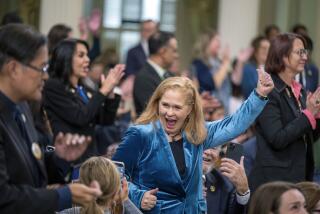CAPITOL JOURNAL : Remapping Shows Where the Truth Lies
SACRAMENTO — Perhaps no other political event generates so many truths, and untruths, as the once-a-decade spectacle during which state legislators try to draw the districts in which they will run for the next 10 years.
The opening act of the 1991 version of this insiders’ drama has just concluded. The Democratic-controlled Legislature passed several plans that seemed to favor Democrats, and Republican Gov. Pete Wilson promptly vetoed them. The state Supreme Court now has entered, stage right.
These legislative theatrics may not have been remarkable for their results. But they did provoke from state lawmakers an astounding level of candor, and, at the same time, a few exaggerations that by some standards might be considered lies.
The truth-telling, something not always associated with the political process, was driven by the fact that many of California’s elected officials consider their districts to be their personal domains. Incumbents believe in their hearts--and it says in the Constitution--that they have the right to carve up the state as they see fit, provided that a majority of their colleagues and the governor go along.
The idea that districts ought to be drawn to reflect the characteristics of the state’s communities instead of the desires of the current officeholders is, to the incumbents, a fantasy held only by the naive--academics, editorial writers and other do-gooders.
So it did not seem odd for Assemblywoman Teresa Hughes of Los Angeles, who wants to run for the state Senate, to ask Senate leaders to redraw the lines of the district she would like to represent. Hughes also wanted to have the honor of representing her parents in the Legislature’s upper house, and the district she had her eye on did not include the family home.
Trouble was, the little zigzag in the boundaries that Hughes requested would have moved not only her parents but 45,000 other people from one district to another. And because it shifted the racial balance of both districts, it might have violated the federal law that protects the voting rights of ethnic minorities--Hughes among them.
Senate Republican Leader Ken Maddy of Fresno was among those who rejected Hughes’ plea. But it wasn’t because he didn’t understand her motivation. Maddy candidly acknowledged that the Senate plan he endorsed along with the Democratic leadership would protect the careers of nearly every incumbent.
The plan turned two Democratic-leaning districts into solid Republican seats, but then strengthened the grip of the remaining incumbents in almost every district where the current officeholder expected a credible challenge.
“Whenever you are doing a plan that you need both parties to vote for, you strengthen your weaker members,” Maddy explained. “Why would you expect incumbents to vote for a plan that doesn’t help incumbents?”
At one public hearing, Senate Leader David A. Roberti of Los Angeles gazed at a proposed district for the State Board of Equalization, a tax agency, and noted that it appeared to be “too marginal.” Marginal for whom? “For the incumbent,” Roberti said.
Democratic Assembly Speaker Willie Brown straddled the candor fence. For more than a year, Brown frankly told anyone who would listen that his top priority would be to fulfill the desires of incumbents. At one point, he said his aides were so fixed on serving incumbents that they could not begin drawing new maps until they knew which members would be running for Congress and which would stay in the Assembly.
But Brown reversed stride later, when he was urging the Assembly to override Wilson’s veto. Then, he described his plan as “devoid of adherence to incumbents’ preferences.”
In a floor speech, Brown ran through a list of Democrats who had asked for safer districts. He said he told them there was nothing he could do to help. A look at Brown’s plan, however, showed that at least four of those he had named were, in fact, getting better districts.
Brown wanted to have it both ways. After trying to make the point--for the public--that the plan was not good for incumbents, he castigated Republicans for refusing to override the governor’s veto even though “every single, solitary” Republican seat would be better in 1992 than it was in 1990.
Now Brown is saying publicly that he will be happy to have the Supreme Court draw the lines. But the wishes of incumbents will be the last, not the first, priority for the justices. It should not come as a shock, then, if before the court completes its handiwork Brown returns to the bargaining table with a new proposal--one that will please both Democratic and Republican officeholders.
More to Read
Get the L.A. Times Politics newsletter
Deeply reported insights into legislation, politics and policy from Sacramento, Washington and beyond. In your inbox three times per week.
You may occasionally receive promotional content from the Los Angeles Times.










